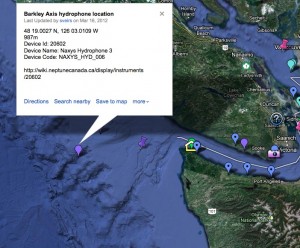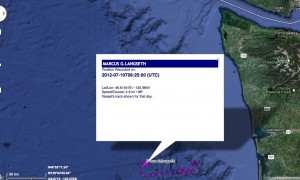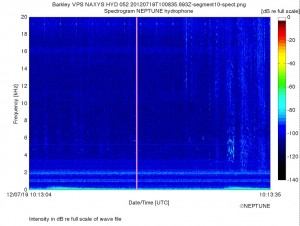Dolphins react to air gun blasts 150 km away?
Last June (2012) marine mammal researchers and stewards around the Pacific Northwest were surprised to learn of seismic research cruises that would use air guns to survey faults and crustal structure on the outer coast of Washington and Oregon. Our concern was that there would be inadequate mitigation of potential acoustic impacts on marine species (particularly southern resident killer whales). It all happened very fast and I never heard much about how it went… until now.
Thanks to John Dorocicz who has been logging acoustic highlights from one of the hydrophones maintained by NEPTUNE Canada near the head of Barkley Canyon, I just had the rare opportunity of hearing airgun blasts in the real ocean — complete with simultaneous vocalization of nearby dolphins. The date and time of the recording match up very well with a cruise track of the R/V Langseth, the research vessel from Columbia University’s Lamont Doherty Earth Observatory.
Here’s where the Barkley Canyon hydrophone is located:
Here’s where marinetraffic.com AIS shows the Langseth was at 8:25 UTC on 2012-07-19, about 175 km south of the hydrophone.
And finally, here is a spectrogram of two seismic blasts recorded at 10:13 on the same day, along with sounds from (likely Pacific White-sided?) dolphins.
Listen to the recording and you’ll notice the low-frequency rumbles of the airgun blasts along with what seems like an increase in dolphin vocalizations (visible as wiggles at 4-6 kHz in the last fifth of the spectrogram). I wonder if these were the first two blasts the dolphins experienced. If so, then the suggestion (made by John initially) that the dolphins are responding to the blasts seems tenable. But were there many blasts before this recording was made? And why wouldn’t they react as much to the first blast in this recording as they seem to react to the second blast?
Regardless of the answers, it is exciting to hear what airguns sound like on Washington’s outer coast at a range of nearly 200 km. The number of marine animals exposed to the sounds of seismic exploration is staggering and begs the question: is the risk of interfering with so many oceanic lives worth knowing more about the subduction zone that may someday rock our west coast cities?
Read More





 Twitter
Twitter LinkedIn
LinkedIn Facebook
Facebook